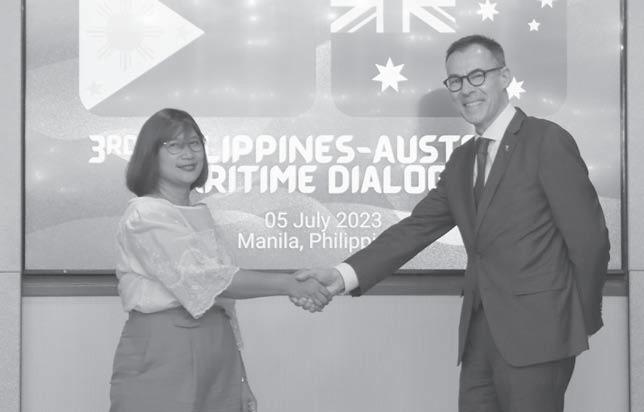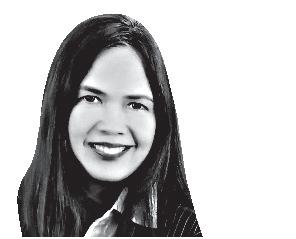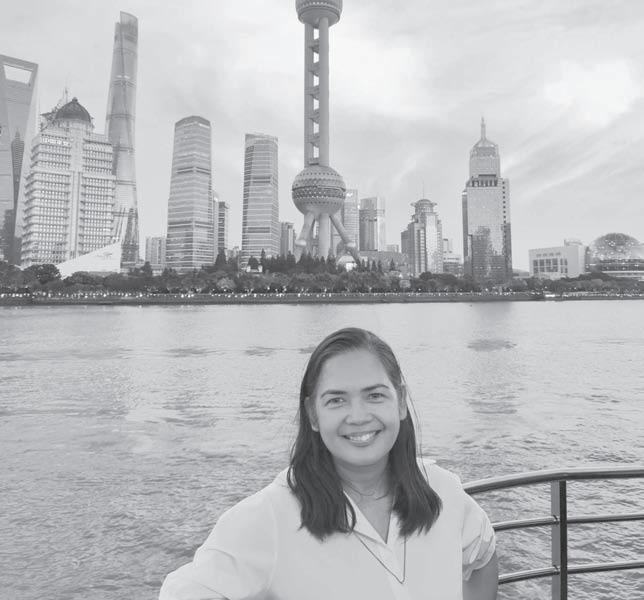
5 minute read
PHL, Australia enhance ties in third maritime dialogue
This, as the former hosted the third edition of their maritime dialogue on July 5 in Manila. Foreign Affairs Assistant Secretary Maria Angela A. Ponce of the Department of Foreign Affairs’ (DFA) Maritime and Ocean Affairs Office and First Assistant Secretary Dr. Peter Sawczak of the United States and Indo-Pacific Strategy Division of the Australian Department of Foreign Affairs and Trade led their respective delegations.
Discussions focused on regional maritime threats and challenges, maritime safety and security cooperation, as well as marine-environmental protection, as key Philippine maritime and security agencies par- ticipated in the dialogue.
Both delegations also tackled defense cooperation, bilateral and regional maritime-cooperation initiatives, other opportunities for close collaboration, plus cooperation in international organizations.
“The [DFA has long had the mandate to expand and deepen bilateral political, economic and people-to-people ties, but we have not always had peers when we have wanted to expand the discourse in the maritime space. Until, that is, we were met with the level of interest and commitment of Australian government], and were able to craft this new generation of maritime dialogues, comple-
Dispatch
menting the political track,” remarked Ponce, who underscored the centrality of maritime issues in Philippine foreign policy.

Positive outcomes of the platform in 2021, said the DFA official, has “led to the continued partnership, with a third iteration in 2023. [It set the trend toward a fuller realization of the role maritime security and cooperation plays in the bilateral agenda, which is only natural given that both
By Ambassador David Hartman
our countries] are maritime nations.”
A “Track 1.5 Dialogue” preceded the maritime discussion, as both foreign ministries’ partner-institutions took the lead: the University of the Philippines-Institute for Maritime Affairs and Law of the Sea for the Philippines, and La Trobe Asia for Australia.
Both delegations are expected to meet anew in their fourth maritime dialogue in 2024.
BEIJING,China—WhenPresident

Ferdinand Marcos Jr. visited Beijing in January, it was a cold, bitter winter’s day, and the Covid-19 Omicron variant was on a rampage.
Fast forward to six months, a delegation of Philippine government communications and media practitioners went on a visit to follow-through on the agreement between the Chief Executive and his counterpart President Xi Jinping to boost people-to-people ties. This time Beijing was experiencing its hottest weather at 40-degrees Celsius, while the pandemic is now practically a thing of the past.
I was fortunate to be part of the Philippine media delegation that toured seven cities of China from June 27 to July 7, 2023. I thought it was the usual media familiarization tour offered to journalists like me. My first visit to China in 1999 was also part of the Philippine media and national artists delegation who joined China’s biggest party of the 50th founding anniversary. So, I thought to myself: “China is resuming its public-relations offensive to the Philippine press, huh?”
But the trip was more than just that.
It felt like a high-level visit—almost as if we were members of the administration’s cabinet. So I thought China was being “extra nice,” especially with Presidential Communications Office (PCO) undersecretary Gerald Baria among the delegation. We didn’t have Chinese “minders,” but the Ministry of Foreign Affairs assigned to us three ranking diplomats: a counselor, first secretary and third secretary. We were feted with banquet dinners and luncheons from the MFA Vice Minister Sun Wei-dong, and top ranking officials from the Com- munist Party of China at the local level. From airports, train stations and even at tourist attractions, we were escorted to VIP lanes. During our two-week visit, we were booked in five-star hotels that even managers said would be hard to pull-off because it was one of the busiest seasons of the year, as children were on school vacation.
Later at the end of the trip, I only realized that we are such a “major” or “big-deal” of the delegation when I saw that state broadcaster CGTN deployed two senior reporters—one is the bureau chief in Washington, DC; and another Beijing-based political reporter to cover our visit, and not just witness what we are supposed to be covering. Then in Shanghai, CGTN’s desk editor for international news, as well as a reporter for digital news and his cameraman, were also deployed. (As a former news editor of GMA News, assigning three reporters and a desk editor would be an “overkill” and waste of resources. So, that’s the only time that the idea of our delegation’s “bigness” sank in.)
I shared this with Baria in one of our chats on the last day of our trip in Shanghai. He confided in me in Filipino that it was a good thing I mentioned such to him; else, it would have rather made him “nervous.” The PCO official happens to be a low-key undersecretary for content production, who joined Marcos Jr. in his trips overseas. I only learned that Baria would be joining our delegation the day before we left for Beijing, and my Google search only mentioned that he used to be the cameraman of BBM Vlog. (In one of our meetings, a Chinese senior official mentioned Baria’s background as a chemical engineer, and went on to share possible cooperation on mineral resources between the Philippines and China.)
Although we were treated like royalty, we were also herded incessantly to various tourist destinations: the Summer Palace, Great Wall, Everbright City and the museum of terracotta warriors in Xi’an, Zhangjiajie Forest Park to the Bund in Shanghai, just to name a few. Sometimes, I would dub it as the Pinoy “Amazing Race: China edition.” Our hosts were apologetic, of course, as they had to endure the same level of stress and panic so we won’t miss our schedules. The nagger that I am, of course, I complained. But when the hosts flashed their smiles and laughed at our silly jokes, all was well again.
At the end of the trip, I had a better “understanding” of China, because the Communist country that I knew before the end of the last millennium was still struggling. The Chinese vice foreign minister said they have already eradicated extreme poverty, and are on their way to becoming a developed economy. While I had no way of quickly validating such, it seems that from the number of Chinese who literally swarmed tourist attractions with us, I guess it is true.
In 1999 I saw thousands of motorcycle riders along the avenues of Beijing. Now, they just rent e-bikes and commute in subways, commuter buses and trains. We spoke with pioneers of firms whose buzzwords are “research and development,” artificial intelligence, as well as openness to do business in the Philippines.
Some would probably say that we were “sold” by the Chinese to their good side with their lavish hosting of our trip. I would probably have had the same line of thinking if I were not invited. But we were not required to write anything from our two-week adventure. Despite spending probably millions of pesos for this trip, they were gracious enough to say that they just needed us to “understand” China. I gave them my “two cents” every now and then. I agree, though, that there is no better way than people-to-people exchanges for us to thaw our freezing relationship and to live “in harmony” not just as neighbors, but as “brothers and sisters.”
So to every one who gave us their all during this visit, a big “Xie xie!”






